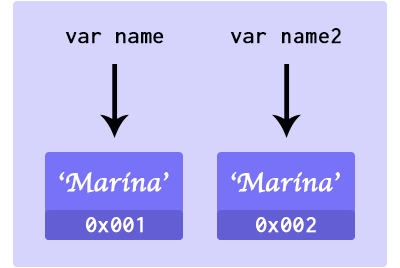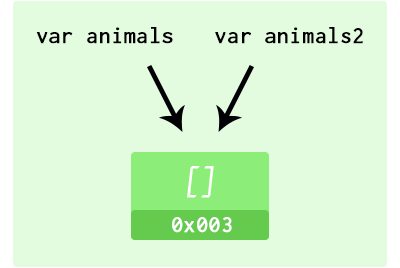Reference vs Value in JavaScript
This post discusses how the various Javascript data types behave when being assigned to a variable. Depending on the data type, memory is allocated differently to store it. It may reserve a new space to store a copy of the value or don’t create a copy at all and just point to the existing value (reference). Notes taken while following Javascript30 course from Wes Bos.
Numbers, Strings and Booleans
In JavaScript, Primitive Types such as undefined, null, string, number, boolean and symbol are passed by value.
let name = 'Marina';
let name2 = name;
console.log({name, name2});
>> { name: 'Marina', name2: 'Marina' }
name = 'Vinicius';
console.log({name, name2});
>> { name: 'Vinicius', name2: 'Marina' }

When the variable name is assigned, a space in memory with an address of 0x001 is reserved to store that value. The variable name then points to that address.
The variable name2 is then set to equal name. A new space in memory, with a new address 0x002 is allocated and stores a copy of the value stored in the address name points to.
So, whenever we want to modify the value of name, the value stored by name2 won’t be changed, since its a copy, stored in a different location.
Objects and Arrays
Objects in JavaScript are passed by reference. When more than one variable is set to store either an object, array or function those variables will point to the same allocated space in memory.
const animals = ['Cat', 'Dog', 'Horse', 'Snake'];
let animals2 = animals;
console.log({animals, animals2});
>>
{
animals: ['Cat', 'Dog', 'Horse', 'Snake'],
animals2: ['Cat', 'Dog', 'Horse', 'Snake']
}
animals2[3] = 'Wale';
console.log(animals, animals2);
>>
{
animals: ['Cat', 'Dog', 'Horse', 'Wale'],
animals2: ['Cat', 'Dog', 'Horse', 'Wale']
}

When animals is set to store an array, memory is allocated and an address is associated to that variable. Then animals2 is set to equal animals. Since animals stores an array, instead of creating a copy of that array and a new address in memory, animals2 is simply pointed to the same object in the existing address. That way any changes made to animals2 will reflect on animals, because they point to the same location.
Same behavior for objects:
const person = {
name: 'Marina',
age: 29
};
let femme = person;
femme.age = 18;
console.log({person, femme});
>>
{
person: { name: 'Marina', age: 18 },
femme: { name: 'Marina', age: 18 }
}
Copying Objects and Arrays
Since a simple assignment is not enough to produce a copy of an object, that can be achieved by other approaches:
Arrays
slice()
let animals2 = animals.slice();
animals2[3] = 'Shark';
concat()
let animals3 = [].concat(animals);
animals3[3] = 'Tiger';
spread (ES6)
let animals4 = [...animals];
animals4[3] = 'Lion';
Changes will affect only the object modified:
console.log({animals, animals2, animals3, animals4});
>>
{
animals: ['Cat', 'Dog', 'Horse', 'Snake'],
animals2: ['Cat', 'Dog', 'Horse', 'Shark'],
animals3: ['Cat', 'Dog', 'Horse', 'Tiger'],
animals4: ['Cat', 'Dog', 'Horse', 'Lion']
}
Objects
assign()
let human = Object.assign({}, person, { age: 20 });
console.log(person, human);
>>
{
person: { name: 'Marina', age: 29 },
femme: { name: 'Marina', age: 20 }
}
Deep Clone
It’s important to note that those methods are just one level deep. For deep clones there is a frowned upon method. Use carefully.
let femme3 = JSON.parse(JSON.stringify(person));
femme3.name = 'Leslie';
console.log(person, femme3);
>>
{
person: { name: 'Marina', age: 29 },
femme3: { name: 'Leslie', age: 29 }
}
References
- JavaScript 30 - WesBos
- You Don’t Know JS: Scope & Closures by Kyle Simpson






